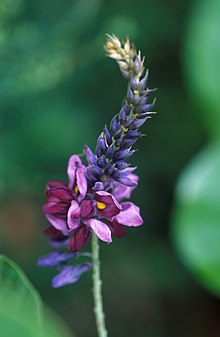**1. Botanical Characteristics and Taxonomy:**
– Fabaceae, also known as legumes, is the third-largest plant family with approximately 19,500 known species.
– The family is divided into three subfamilies: Caesalpinioideae, Mimosoideae, and Papilionoideae.
– Fabaceae plants exhibit a wide range of growth habits, from giant trees to small annual herbs, with unique leaf structures and symbiotic relationships with nitrogen-fixing bacteria.
– The exact branching order of subfamilies within Fabaceae is unresolved, but the family is consistently recovered as monophyletic.
– Taxonomic systems typically place Fabaceae in the order Fabales.
**2. Evolutionary History and Biogeography:**
– Fabaceae diversified during the Paleogene period, with fossils dating back to the Tertiary period.
– Main Cesalpinioideae clades date back 56-34 million years, while divergence within Faboideae occurred around 58.6 million years ago.
– Evolutionary studies have documented the rapid diversification of legume lineages during the Tertiary period.
– Biogeographic patterns in early-diverging clades of Leguminosae have been studied to understand historical dispersal and diversification.
– Global distribution patterns of Fabaceae have been analyzed based on recent phylogenies for conservation and evolutionary insights.
**3. Symbiotic Relationships and Nitrogen Fixation:**
– Fabaceae plants play a crucial role in nitrogen fixation, with many species hosting rhizobia bacteria in root nodules.
– Legumes have evolved symbiotic relationships with nitrogen-fixing bacteria to enhance soil fertility.
– Legume haemoglobins and nodulation genes are essential for symbiotic nitrogen fixation in legumes.
– Functional adaptations in plant receptor-kinase have facilitated intracellular root symbioses with bacteria.
– Nodules for biological nitrogen fixation are mainly located in the root cortex, and the process is common in Fabaceae, with various types found across subfamilies.
**4. Economic and Ecological Importance:**
– Legumes are economically and culturally significant, with uses ranging from food and forage to industrial applications.
– Legumes have been a staple in human civilization since 6,000 BCE, offering benefits like atmospheric nitrogen fixation and high protein content.
– Fabaceae plants are essential for soil fertility, ecosystem health, and global food security.
– Legume crops contribute significantly to sustainable agriculture, including agroforestry systems.
– Fabaceae species are vital for bee pollination, honey production, and the production of natural gums and dyes.
**5. Molecular Phylogeny and Chemical Ecology:**
– Molecular evolution studies based on sequences like rbcL and plastid matK gene analysis have helped in understanding the phylogeny of Fabaceae.
– The Legume Phylogeny Working Group has proposed a new subfamily classification to enhance our understanding of the family’s evolutionary relationships.
– Many leguminous plants produce chemicals derived from 3-nitropropanoic acid, with ecological importance due to their widespread occurrence.
– Isoxazolin-5-one derivatives occur in conjunction with 3-NPA in some species, impacting mitochondrial respiration and nerve cells.
– Understanding the chemical ecology of Fabaceae species is essential for conservation efforts and ecological studies.
The Fabaceae (/fəˈbeɪsi.iː, -ˌaɪ/) or Leguminosae, commonly known as the legume, pea, or bean family, are a large and agriculturally important family of flowering plants. It includes trees, shrubs, and perennial or annual herbaceous plants, which are easily recognized by their fruit (legume) and their compound, stipulate leaves. The family is widely distributed, and is the third-largest land plant family in number of species, behind only the Orchidaceae and Asteraceae, with about 765 genera and nearly 20,000 known species.
| Fabaceae Temporal range:
| |
|---|---|

| |
| Kudzu (Pueraria lobata) | |
| Scientific classification | |
| Kingdom: | Plantae |
| Clade: | Tracheophytes |
| Clade: | Angiosperms |
| Clade: | Eudicots |
| Clade: | Rosids |
| Order: | Fabales |
| Family: | Fabaceae Lindl. (Leguminosae Jussieu, nom. cons.). |
| Type genus | |
| Faba (now included in Vicia) Mill.
| |
| Subfamilies | |
| |
| Diversity | |
| 730 genera and 19,400 species | |

| |
| Fabaceae distribution map. Legumes are found in four major biomes: tropical forest, temperate, grass, and succulent. | |
| Synonyms | |
The five largest genera of the family are Astragalus (over 3,000 species), Acacia (over 1,000 species), Indigofera (around 700 species), Crotalaria (around 700 species), and Mimosa (around 400 species), which constitute about a quarter of all legume species. The c. 19,000 known legume species amount to about 7% of flowering plant species. Fabaceae is the most common family found in tropical rainforests and dry forests of the Americas and Africa.
Recent molecular and morphological evidence supports the fact that the Fabaceae is a single monophyletic family. This conclusion has been supported not only by the degree of interrelation shown by different groups within the family compared with that found among the Leguminosae and their closest relations, but also by all the recent phylogenetic studies based on DNA sequences. These studies confirm that the Fabaceae are a monophyletic group that is closely related to the families Polygalaceae, Surianaceae and Quillajaceae and that they belong to the order Fabales.
Along with the cereals, some fruits and tropical roots, a number of Leguminosae have been a staple human food for millennia and their use is closely related to human evolution.
The family Fabaceae includes a number of plants that are common in agriculture including Glycine max (soybean), Phaseolus (beans), Pisum sativum (pea), Cicer arietinum (chickpeas), Vicia faba (broad bean), Medicago sativa (alfalfa), Arachis hypogaea (peanut), Ceratonia siliqua (carob), Trigonella foenum-graecum (fenugreek), and Glycyrrhiza glabra (liquorice). A number of species are also weedy pests in different parts of the world, including Cytisus scoparius (broom), Robinia pseudoacacia (black locust), Ulex europaeus (gorse), Pueraria montana (kudzu), and a number of Lupinus species.
